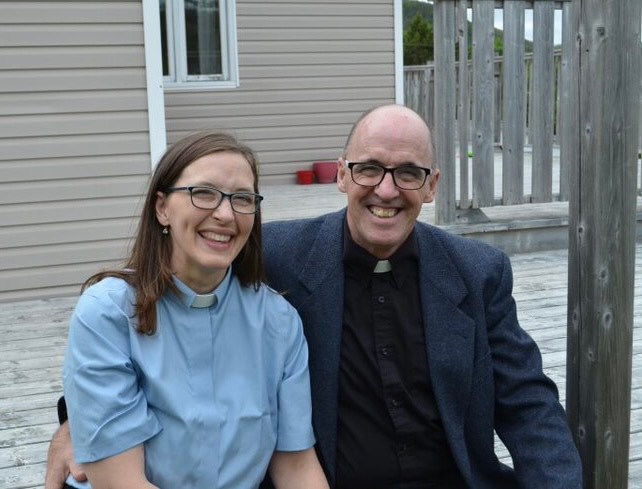- Home
- simply catholic
- Catholic Priests Were Forced to Divorce
Simply Catholic and Welcoming You
Catholic Priests Were Forced to Divorce

Archbishop Philip and Bishop Charlene Bradley - A Married Couple who are Both Clergy in St. Brigit's Community Catholic Church
Catholic priests were forced to divorce even though they had been allowed to marry up until 1139 which is when the 2nd Lateran Council commanded all priests be celibate. Married priests were forced to “divorce”. However, since Catholics can’t get divorced, the church ruled that the marriages were “invalid” to begin with. This despite the marriages having followed proper form and being done in the church and producing children!
Children from those marriages were taken from their homes and made to live a life of service to the church.
Priests who spoke out against this were “silenced” by the church as the Catholic Magisterium demands full submission of mind and will to the church’s teachings under threat of excommunication.
The public struggled with the fact that an ecumenical council commanded something which most people saw as wrong and sinful. Still, in those days, most people were literally uneducated and illiterate so they struggled to understand while unable to actually study accounts of what was happening.
Indeed the church today questions the ecumenicity of the Lateran 1 and 2 councils.
“This council is called “general” in the records and more frequently “plenary” by Pope Innocent the second himself (the pope who called the 2nd Lateran Council). However, there is a doubt as to its ecumenicity for the same reasons that affect Lateran I.” States the Papal Encyclicals Online.
( https://www.papalencyclicals.net/councils/ecum10.htm )
Catholic Priests Were Forced to Divorce by These Specific Canons

Bishops Philip and Charlene Bradley Share a Moment of Levity Following Mass - Married Couples Can Indeed be Devoted to Each other AND be Devoted Clergy
Of the 30 Canons released by this council the following relate to the subject of this discussion:
Can 6. We also decree that those in the orders of sub deacon and above who have taken wives or concubines are to be deprived of their position and ecclesiastical benefice. For since they ought to be in fact and in name temples of God, vessels of the Lord and sanctuaries of the holy Spirit, it is unbecoming that they give themselves up to marriage and impurity.
Can 7. Adhering to the path trod by our predecessors, the Roman pontiffs Gregory VII, Urban and Paschal, we prescribe that nobody is to hear the masses of those whom he knows to have wives or concubines. Indeed, that the law of continence and the purity pleasing to God might be propagated among ecclesiastical persons and those in holy orders, we decree that where bishops, priests, deacons, subdeacons, canons regular, monks and professed lay brothers have presumed to take wives and so transgress this holy precept, they are to be separated from their partners. For we do not deem there to be a marriage which, it is agreed, has been contracted against ecclesiastical law. Furthermore, when they have separated from each other, let them do a penance commensurate with such outrageous behaviour.
Can 8. We decree that the selfsame thing is to apply also to women religious if, God forbid, they attempt to marry.
Can 21. We decree that sons of priests are to be removed from the ministries of the sacred altar unless they are living religiously in monasteries or canonries.
Bear in mind that these were different times and the church’s power was so nearly absolute that they included Canon 20;
Can 20. As is right, we do not deny to kings and princes the power to dispense justice, in consultation with the archbishops and bishops.
That’s right, they extend the right of kings and princes to dispense justice yet have made doing so conditional upon proceeding “in consultation with the archbishops and bishops.”
Note also the patriarchy. No mention of the power of queens or princesses.
It has long been claimed that the real reason for these decrees was made clear in the council's Canon 5.
Can 5. We enjoin that what was laid down in the sacred council of Chalcedon be rigidly adhered to, namely, that the goods of deceased bishops are not to be seized by anyone at all, but are to remain freely at the disposal of the treasurer and the clergy for the needs of the church and the succeeding incumbent. Therefore, from now on, let that detestable and wicked rapacity cease. Furthermore, if anyone dares to attempt this behaviour henceforth, he is to be excommunicated. And those who despoil the goods of dying priests or clerics are to be subject to the same sentence.
Yep, this all started over arguments that the wives and children of clergy who died could or could not claim property or other benefits given to the cleric during their ministry. The church was making sure that anything used for church purposes became permanently church owned and, by these decrees, ensured no further arguments for entitlements by future generations.
In Conclusion
So Yes, for the first 1139 years of the Catholic church clergy did indeed get married. Even today only the clergy of the Latin/Roman Rite must vow celibacy.
Thankfully none of the other Catholic Rites followed these extreme decrees. Indeed all other Catholic Rites have continued, to this day, to operate with married clergy up to and including married episcopate/bishops citing 1 Timothy 3:2 which describes the character traits expected of a church leader, or "overseer" or "bishop." These traits include being above reproach, faithful to one's spouse, self-controlled, sensible, respectable, hospitable, and able to teach.
The verse provides a foundational list of personal qualities essential for anyone in a leadership position within the church, emphasizing moral uprightness, wisdom, and community engagement.
All other Catholic Rites/churches still continue to operate with married clergy.
Recent Articles
-
Catholic-Confession
Apr 19, 25 08:53 PM
Full breakdown of the Catholic Confession Sacrament of Reconciliation -
Ordination, incardination and dismissal of clergy
Mar 03, 25 06:47 PM
Overview of Ordination to Holy Orders, incardination and dismissal of clergy -
Catholic Last Rites
Mar 03, 25 06:41 PM
An explanation of the Catholic Last Rites and Anointing of the Sick
Boat Harbour West, Newfoundland, Canada. Cell Number 709-276-0626


